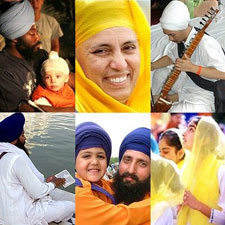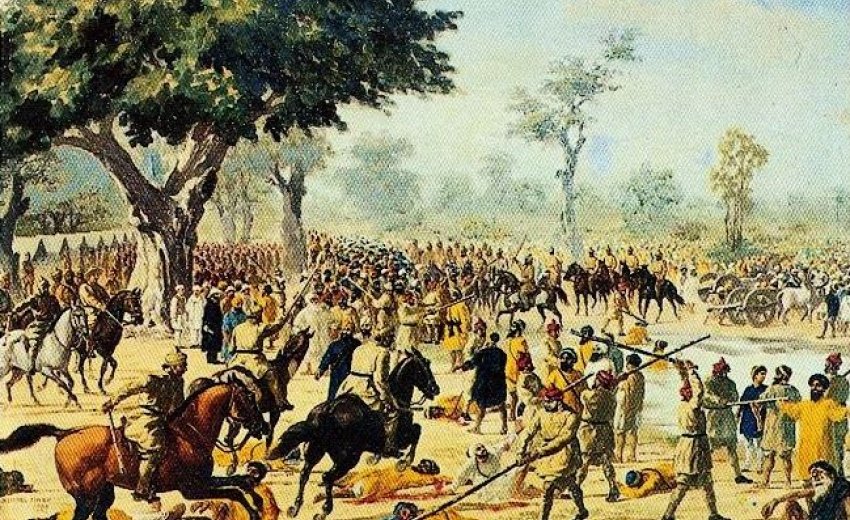 Revisiting a Revolutionary Event from Sikh Tawarikh
Revisiting a Revolutionary Event from Sikh Tawarikh
Guru-Ka-Bagh Morcha (8th August- 23rd November, 1922) :
The Guruduara Guru-ka-Bagh, 20 kms from Amritsar, during the months of August till November in 1922, witnessed non-violent active resistance by common citizens of the land, which displayed the physical strength, psychological stamina and conscious courage of the Son-of-the-Soil Sikhs who participated in the morcha.
Every day hundreds of Sikhs would take vow at Akaal TaKht to pursue their peaceful and non-violent active resistance against government appointed Guruduara caretakers and British Imperialism, as a fight for Justice and Freedom. The issue was over the rights to cut trees from a farmland adjoining the Guruduara, so as to use the wooden logs in preparing Langar for common people. The government denied the access by citing that it is private property of their own personnel. Initially it was a local issue, but turned into an issue of National interest as it portrayed the fight between right to self-determination of a common citizen against immoral and discriminatory actions of imperialist government.
From August 8th till November 23rd, the Guru-ka-Bagh became the center of Indian Freedom Struggle and was visited by all major leaders involved in freedom movement from various political parties and many of them applauded the efforts and endurances faced by the participating Sikhs in the morcha.
The English missionary and educator, C.F. Andrews (1871-1940) visited Guru-Ka-Bagh, and sent a detailed report to British and Indian Press with following headlines.
"Hundreds of Christs being Crucified" - September 12th, 1922. [1]
He further wrote in his report ........." It was a sight which I never wish to see again, a sight incredible to an Englishman. There were four Akali Sikhs with black turbans facing a band of about a dozen policemen, including two English officers... They were perfectly still and did not move further forward. The hands of the Akali Sikhs were placed together in prayer and it was clear that they were praying. Then without the slightest provocation on their part, the Englishman lunged forward, the head of his lathi that was bound with brass. He lunged it forward in such a way that his fist that held the staff struck the Akali Sikh, who was praying, just at the collarbone with great force. It looked like the most cowardly blow as I saw it struck. The blow which I saw was sufficient to fell the Akali Sikh and send him to the ground. He rolled over and slowly got up once more, and faced the same punishment over again. ......................... The vow the Akali Sikhs had made to God was kept. I saw no act, no look of defiance. It was true martyrdom for them as they went forward, a true act of faith, a true deed of devotion to God." [1]
"I salute the Akalis who have started the struggle for freedom and are fighting for it" – Pandit Moti Lal Nehru. [2]
"Guru-ka-Bagh Morcha has given birth to the freedom movement which must lead us to Swaraj" – Pandit Madan Mohan Malaviya. [2]
"The Sikh brothers have shown us the way to freedom; no one can keep us slaves any more" – Dadabhai Naoroji. [2]
"I rejoice that I am being tried for a cause which the Sikhs have made their own. I was in jail when the Guru-ka-Bagh struggle was gallantly fought and won by the Sikhs. I marveled at the courage and sacrifice of the Akalis and wished that I could be given an opportunity of showing me deep admiration of them by some form of service. That opportunity has now been given to me and I earnestly hope that I shall prove worthy of their high tradition and fine courage. Sat Sri Akal. "
-From Nabha Central Jail. Jawaharlal Nehru - 25th Sep. 1923 [3]
Sir Edward Maclagan, Lt-Governor of the Punjab, visited Guru-ka-Bagh on 13 September 1922. Under his orders, the beating of the volunteers was stopped. Mass arrests, imprisonments, heavy fines and attachment of properties were resorted to. In the first week of October, the Governor-General Lord Reading held discussions with the Governor of the Punjab at Shimla to find a way out of the impasse. In the end the land was acquired on lease, on 17 November 1922, which allowed the Akalis access to it. On 27 April 1923, Punjab Government issued orders for the release all of the prisoners. [4]
Thus, ended the morcha of Guru-ka-Bagh, restoring a common citizen's self-esteem. The success of the morcha displayed the Patriotism of Punjabi's and Spirit of Sikhs to struggle for self-determination, Justice and Freedom.
In 4 months of struggle, 936 Sikhs were seriously wounded and hospitalized and 5,605 Sikhs went to jail. [5].
References:
[1] Encyclopedia of Sikhism – By Harbans Singh
[2] Sikh in the Freedom Struggle – K S Duggal
[3] Jawaharlal Nehru – A Biography by Sankar Ghose
[4] Internet Website
[5] A History of the Sikhs – Vol2, Khushwant Singh . Page 204
